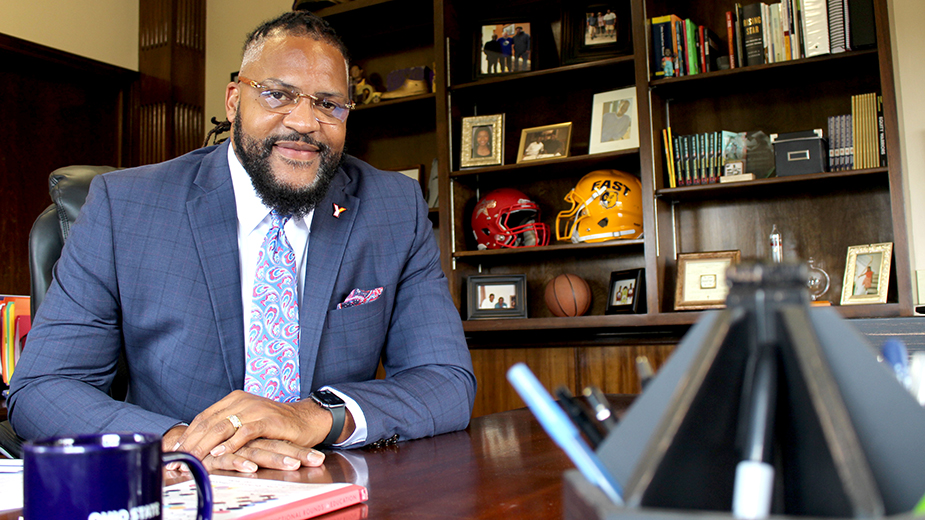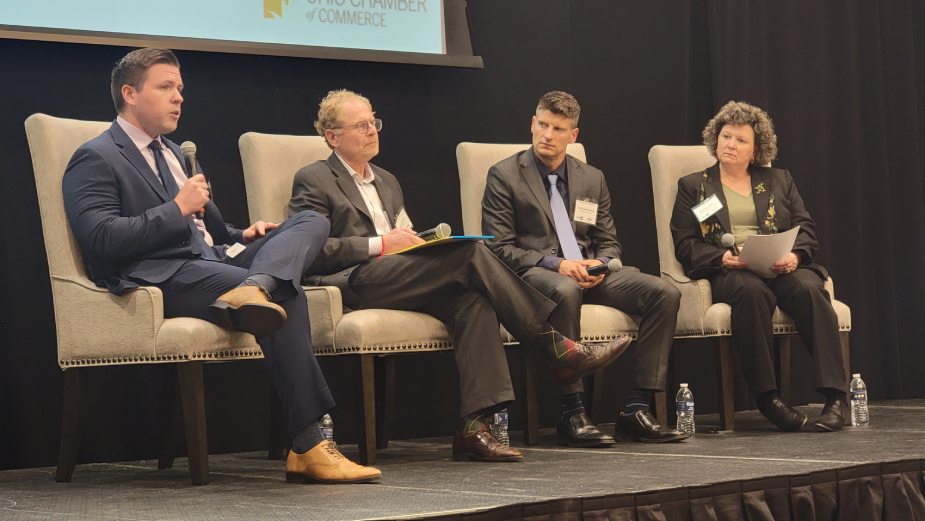Teacher Shortage Begins to Hit Mahoning Valley
YOUNGSTOWN, Ohio – Educators and administrators here are doing their part to head off what could prove to be a catastrophic national teaching shortage.
Local school districts are starting to feel the effects. The Youngstown City Schools has 13 teacher openings across the district, according to its job recruitment website: four elementary, seven high school and two middle school positions. Most of the openings are for positions in science and math, Superintendent and CEO Justin Jennings reports.
“Just like everybody else, we definitely have a teacher shortage, especially in the math and sciences,” Jennings says. “It’s having an impact. But right now, not a huge impact because we’ve been able to manage it.”
Experts anticipated the shortage for years because of declining enrollment in education programs at universities. Research published in 2019 by the Center for American Progress found that nationally, there were more than one-third fewer students enrolling in 2018 than in 2010.
Ohio posted a decline of nearly 50% and is one of nine states where the drop in enrollees totaled more than 10,000 between 2010 and 2018.
As enrollment continues its steep decline, education experts and professionals are working to find solutions through recruitment programs and by changing the narrative around the profession.
LOCAL PERSPECTIVE
As an urban district, Youngstown is not alone in its need for teachers. The crisis in Ohio is acute and concentrated in urban areas, observes Ohio Education Association President Scott DiMauro. “I think it’s more acute, especially in more urban districts with higher levels of poverty and districts that maybe don’t have as many resources,” he says.
Jennings acknowledges that money is not going to be what sells a teacher on working in his district. He accepts the harsh reality of what the district is able to pay. Starting salaries for teachers vary greatly based on a candidate’s education and experience, but lingers between the $35,000 and $45,000, based on the salary schedule for this coming school year.
Jennings says the district tries to support its teachers in other ways. He says it’s a priority that teachers feel valued.
“We try to make sure that they understand they’re safe, protected and ready for professional development,” he says.
The district recently finished renegotiating its contract with its corps of teachers for the first time in some eight years. “[We’re] just really showing them that they’re valued,” Jennings says.
A culture shift may also be partly to blame for teachers leaving the profession, says Carlotta Sheets, human resources supervisor at the Trumbull County Educational Service Center.
“People’s lives change. Sometimes they move away. Sometimes they discover that this profession wasn’t for them,” she says. “It is becoming more the accepted norm that people do change jobs – they move from one position to another. They try different things. They try to maybe better themselves in a different way.”
Sheets says people in the workforce have moved away from the lifelong career ideology and are no longer settling in at a company for 40 years. She notes that people today look to have several careers in their lifetimes.
The Trumbull County ESC provides a wide variety of human resources services to school districts in that county. Sheets says it posts job listings for school districts in Trumbull County, maintains electronic applications for candidates in all fields of education, and helps districts with employment searches.
Sheets says the ESC and the districts it serves are affected by the shortage “just like everybody else.” The ESC’s job listing website reports nine teaching openings across its districts – four high school, one middle school and four elementary. It also lists several openings for other teaching positions, such as music and physical education.
CAUSES AND SOLUTIONS
The problem is twofold, the OEA’s DiMauro says – low enrollment in education programs and teacher retention. The National Education Association found that 55% of teachers are leaving, or planning to leave, the profession earlier than planned. A Gallup study found that 52% of K-12 teachers report feeling constantly burned out at work.
“An increasing number of people are saying, ‘Hey, I’m feeling burnt out and I’m feeling not supported or economically I need to do something else.’ And they’re either retiring early or leaving the profession for other work,” he says.
DiMauro adds that teachers must be trusted with teaching. In today’s political climate and debates over education policies, book bans and other “culture war issues have teachers caught in the crossfire. Supporting and respecting teachers is giving teachers the autonomy to do the jobs that we know they can do,” he says.
Teachers across the country report being underpaid and undervalued, according to the NEA. DiMauro says the only way to recruit and keep teachers is to pay them what they’re worth and support their needs.
“We have to make sure that we have good support systems in place,” he says. “That’s quality mentoring programs, quality professional development, a good alignment between what the preparation is that people are getting before they’re in the classroom – and then how that matches up to the realities of the classroom.”
DiMauro says the most worrisome aspect of the shortage is how it will affect students. Larger class sizes and a lack of academic support for students weigh heavily on the shoulders of teachers and negatively affect their students.
A high turnover rate in teaching positions affects the quality of the education students receive, DiMauro says. Teachers are no longer staying in their positions long enough to gain the experience that improves the quality of learning.
“If you have people that leave after just a couple of years in teaching, then that means you hire new people. Then it takes longer to get them to a place where they have the same level of competency as those with more experience,” he says. “All of those things have a direct impact on quality learning opportunities for kids.”
Another shortage in the teaching field has reached a critical level, according to Pam Epler, assistant professor of special education at Youngstown State University. Epler has watched her class enrollment dwindle from an average of 15 students to only five in this upcoming semester. She says the lack of special education teachers, and future teachers in core subjects, has reached a crisis.
“We are extremely short on special educators. We’re trying to recruit wherever we can,” she says. “We’re short on teachers. Period. But in particular, we are short on folks that want to work with kids with exceptionalities.”
Epler is the supervisor of a $200,000 grant YSU received through the statewide “Addressing Educator Shortages in Ohio” program paid for through $5.2 million in federal COVID-19 relief funds.
YSU’s Beeghly College of Liberal Arts, Social Sciences and Education will focus particularly on increasing the number of students preparing to teach special education. As of February, school districts in the Youngstown area alone reported 26 unfilled special education positions.
Epler says the program aims to recruit people who already have a teaching license and want to get a master’s degree in special education. The grant pays for a third of the tuition for each student. Six students are currently enrolled, she says.
Those looking to get into special education are practically guaranteed a job, Epler says, a job she describes as unlike any other.
“If you’re willing to go into education and you want to work with kids with exceptionalities, this is a good time – you will get a job. I can guarantee you that,” she says. “I like the challenge, if you will, of ‘How can I get this kid to learn or to understand whatever concept that we’re trying to educate them?’ I just think everybody should be a special educator. They’re a great group of kids to work with.”
Under the initiative, YSU will also work in collaboration with the Trumbull and Ashtabula County Educational Service Centers, as well as the Youngstown City and Liberty Local schools, to recruit traditional high school students, current YSU students, students in local community colleges and others to explore getting baccalaureate or master’s degree and entering the teaching profession.
Jennings says his district is working to cultivate an interest in a career in education among high school students. “We’re preparing our high school juniors and seniors to get them into teacher ed programs,” he says. “We’re trying to look at it [the shortage] from the beginning.”
The district has implemented the Educators Rising Program, a nationwide program created to guide high school students into teaching careers. Launched in 2015 as a reimagining of the Future Educators Association, the program provides students with hands-on teaching experience while letting them earn college credit and aims to spark and sustain interest in the profession.
DiMauro says that building an accessible pipeline for talented young people to get into an education career is critical to solving the problem in the long run. Programs that give incentives to graduates to come back and teach in their communities and that offer financial support are all ways to head off the crisis, he says.
Steps also need to be taken at the legislative level for meaningful and lasting change, the OEA leader says. Funding for such programs and money that can be used to increase teacher salaries are all items DiMauro believes should be given priority in federal funding legislation.
“One of the critical things that must happen is that we need the Legislature to make a commitment to a funding plan,” he says. “The fact that there’s attention being paid to this hopefully will create a sense of urgency among policymakers and the public. It’s going to be critical to solving this problem in the long run.”
Pictured at top: Justin Jennings says his district is working with high school students to cultivate interest in teaching careers.
Copyright 2024 The Business Journal, Youngstown, Ohio.



